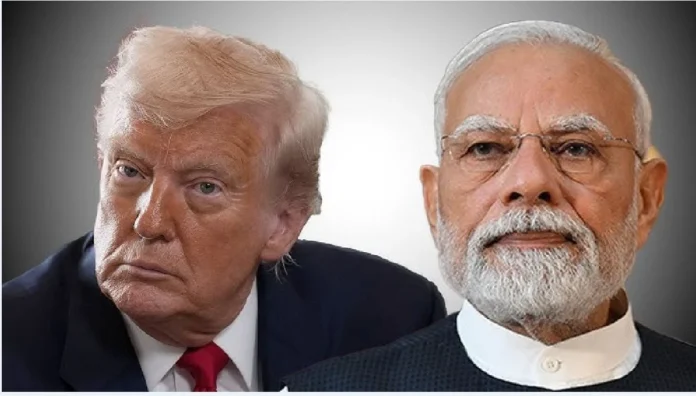By Annunthra Rangan
The storm broke in Washington. In February 2025, Prime Minister Narendra Modi’s visit to the White House produced a bold target: “Mission 500”, a $500 billion trade milestone with the United States by 2030. Within months, optimism collapsed. New Delhi resisted US demands to reduce Russian oil imports and open sensitive sectors to American investors. By June, talks lay in ruins. Retaliation was swift and unforgiving.
On August 1, the Donald Trump administration imposed a first wave of 25 percent tariffs on Indian exports. Weeks later, that levy doubled to an extraordinary 50 percent, striking at the heart of India’s overseas economy. Nearly $87 billion worth of goods—from textiles and gems to pharmaceuticals and chemicals—were suddenly priced out of their largest market. Industry associations warned of a 30 percent export fall, threatening millions of jobs in Gujarat, Maharashtra and Tamil Nadu. Economists projected a 0.8 percent drag on GDP growth over the next two years.
Yet India did not blink. Relief measures for exporters were announced, diversification to Europe, Africa, ASEAN, and West Asia fast-tracked. Global markets took note. Fitch Ratings kept India’s sovereign rating stable, forecasting 6.5 percent growth in 2025-26 driven by resilient domestic demand. India’s message was unmistakable: external shocks may hurt, but they cannot derail.
A CAUTIOUS THAW WITH BEIJING
Even as Washington closed doors, Beijing knocked. The visit of Chinese Foreign Minister Wang Yi to New Delhi in mid-August was the most substantive contact since the Galwan Valley clashes of 2020. For two days, Wang met National Security Advisor Ajit Doval, External Affairs Minister S Jaishankar, and Prime Minister Narendra Modi. For the first time in years, the talks produced not slogans, but mechanisms:
- An Expert Group under the WMCC to explore “early harvest” steps in border delimitation.
- A Working Group on border management, expanding focus beyond Ladakh to the Eastern and Middle sectors.
- Reopening of border trade posts at Lipulekh, Nathu La, and Shipki La.
- Resumption of direct flights between major Indian and Chinese cities.
- Renewed access to Kailash Mansarovar pilgrimages beginning 2026.
- Hydrological data-sharing and enhanced people-to-people exchanges.
These were not cosmetic gestures. They marked a limited, but tangible reset, carefully designed to stabilize ties. Significantly, Beijing also voiced support for India against Trump’s tariffs, framing them as US unilateralism. For Delhi, timing was everything.
Yet trust remains elusive. Memories of Galwan and the Ladakh standoff still scar strategic thinking. The government has emphasized: normalization cannot mean complacency.
THE SCO SUMMIT: STAGE FOR RECALIBRATION
Against this backdrop, the Shanghai Cooperation Organisation summit in Tianjin on August 31-September 1 acquires heightened importance. It will be Modi’s first visit to China in seven years, and his first bilateral meeting with Chinese President Xi Jinping in nearly two years. Sharing the stage with Xi and Russian President Vladimir Putin, Modi will project India’s continued relevance in Eurasian multilateralism, even as it deepens engagement with the US and the Quad.
The optics are powerful: three of the world’s largest powers—India, China, Russia—together, not as adversaries, but as stakeholders in a multipolar order. To Washington, the message is clear: India retains options. To Beijing and Moscow: India is not sliding into a Western alliance.
But symbolism must be read with caution. India is not joining China’s camp. Nor is it abandoning Indo-Pacific commitments. Rather, it is widening its diplomatic bandwidth—hedging without surrendering.
THE BENEFITS AND RISKS OF RAPPROCHEMENT
Rapprochement with China, if carefully calibrated, carries benefits:
- Military relief: reduced border tensions free resources for maritime and regional focus.
- Economic fallback: expanded connectivity offers alternative markets amid tariff disruptions.
- Long-term stability: cooperation on rivers, climate, and exchanges cools hostility.
The risks, however, are equally stark:
- Future coercion through market dependence.
- Technology partnerships with the US endangered by excessive Beijing warmth.
- Pakistan factor, ever the spoiler in Sino-Indian ties.
The solution is not alignment, but compartmentalization: engage where interests overlap, resist where they diverge, and keep expectations modest.
REINFORCING SOUTH ASIA
India also knows credibility begins at home. Its assertiveness in South Asia reflects this recognition.
- In Sri Lanka, naval drills (SLINEX-25) showcased maritime leadership.
- In the Maldives, India restructured its troop presence into aviation and logistics, preserving influence while respecting sovereignty.
- With Bangladesh, it operationalized a $500 million defence credit and expanded connectivity and security cooperation.
Each move signals primacy, countering China’s Belt and Road advances and cementing India’s regional anchor.
STRATEGIC AUTONOMY, REINVENTED
What emerges is not old-style non-alignment, nor one-sided “natural alliance” with the US. It is a pragmatic, multi-vector doctrine:
- Work with Washington on defence, technology, and Indo-Pacific security—but resist coercion on trade.
- Stabilize ties with Beijing to prevent a two-front squeeze.
- Deepen historic energy and security ties with Moscow.
- Cement leadership in South Asia through combined economic and defence tools.
In short, engage all, be beholden to none.
A BALANCING WITH PURPOSE
India’s diplomacy in 2025 is defined not by reaction, but by assertion. It has absorbed Trump’s tariff shocks, cautiously re-engaged Beijing, and reinforced South Asian leadership. It has preserved room to manoeuvre—a precious asset in a turbulent multipolar world.
Yes, dangers remain: Chinese intent is suspect, US pressure will persist, South Asian politics will simmer. But by widening engagement without losing independence, India is crafting space for sovereignty, dignity, and stability.
This is not mere balancing. It is balancing with purpose.
—The writer is a Senior Research Officer at Chennai Centre for China Studies. Her research interests constitute China-WANA (West Asia and North Africa) relations and human rights


